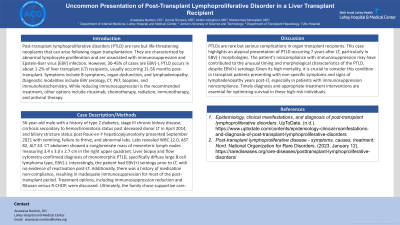Sunday Poster Session
Category: Liver
P1064 - Uncommon Presentation of Post-Transplant Lymphoproliferative Disorder in a Liver Transplant Recipient
Sunday, October 22, 2023
3:30 PM - 7:00 PM PT
Location: Exhibit Hall

Has Audio

Anastasia Naritsin, DO
Lahey Hospital and Medical Center
Woburn, MA
Presenting Author(s)
Anastasia Naritsin, DO1, Umnia Shnawa, MD2, Ahlam Alzoghoul, MD2, Mohammad Almeqdadi, MD3
1Lahey Hospital and Medical Center, Burlington, MA; 2Jordan University of Science and Technology, Irbid, Irbid, Jordan; 3Lahey Hospital, Burlington, MA
Introduction: Post-transplant lymphoproliferative disorders (PTLD) are rare but life-threatening neoplasms that can arise following organ transplantation. They are characterized by abnormal lymphocyte proliferation and are associated with immunosuppression and Epstein-Barr virus (EBV) infection. However, 30-45% of cases are EBV(-). PTLD occurs in about 1-2% of liver transplant (LT) recipients, usually occurring 11-56 months post-transplant. Symptoms include B-symptoms, organ dysfunction, and lymphadenopathy. Diagnostic modalities include EBV serology, CT, PET, biopsies, and immunohistochemistry. While reducing immunosuppression is the recommended treatment, other options include rituximab, chemotherapy, radiation, immunotherapy, and antiviral therapy.
Case Description/Methods: 56-year-old male with a history of type 2 diabetes, stage III chronic kidney disease, cirrhosis secondary to hemochromatosis status post deceased donor LT in April 2014, and biliary stricture status post Roux-en-Y hepaticojejunostomy presented September 2021 with vomiting, failure to thrive, and abnormal labs. Labs revealed WBC 12.0, AST 82, ALT 43. CT abdomen showed a conglomerate mass of mesenteric lymph nodes measuring 3.4 x 3.0 x 2.7 cm in the right upper quadrant. Liver biopsy and flow cytometry confirmed diagnosis of monomorphic PTLD, specifically diffuse large B cell lymphoma type, EBV(-). Interestingly, the patient had EBV(+) serology prior to LT, with no evidence of reactivation post-LT. Additionally, there was a history of medication non-compliance, resulting in inadequate immunosuppression for most of the post-transplant period. Treatment options, including immunosuppression reduction and Rituxan versus R-CHOP, were discussed. Ultimately, the family chose supportive care.
Discussion: PTLDs are rare but serious complications in organ transplant recipients. This case highlights an atypical presentation of PTLD occurring 7 years after LT, particularly in EBV(-) morphologies. The patient's noncompliance with immunosuppression may have contributed to the unusual timing and morphological characteristics of the PTLD, despite EBV(+) serology. Given its high mortality, it is crucial to consider this condition in transplant patients presenting with non-specific symptoms and signs of lymphadenopathy years post-LT, especially in patients with immunosuppression noncompliance. Timely diagnosis and appropriate treatment interventions are essential for optimizing survival in these high-risk individuals.
Disclosures:
Anastasia Naritsin, DO1, Umnia Shnawa, MD2, Ahlam Alzoghoul, MD2, Mohammad Almeqdadi, MD3. P1064 - Uncommon Presentation of Post-Transplant Lymphoproliferative Disorder in a Liver Transplant Recipient, ACG 2023 Annual Scientific Meeting Abstracts. Vancouver, BC, Canada: American College of Gastroenterology.
1Lahey Hospital and Medical Center, Burlington, MA; 2Jordan University of Science and Technology, Irbid, Irbid, Jordan; 3Lahey Hospital, Burlington, MA
Introduction: Post-transplant lymphoproliferative disorders (PTLD) are rare but life-threatening neoplasms that can arise following organ transplantation. They are characterized by abnormal lymphocyte proliferation and are associated with immunosuppression and Epstein-Barr virus (EBV) infection. However, 30-45% of cases are EBV(-). PTLD occurs in about 1-2% of liver transplant (LT) recipients, usually occurring 11-56 months post-transplant. Symptoms include B-symptoms, organ dysfunction, and lymphadenopathy. Diagnostic modalities include EBV serology, CT, PET, biopsies, and immunohistochemistry. While reducing immunosuppression is the recommended treatment, other options include rituximab, chemotherapy, radiation, immunotherapy, and antiviral therapy.
Case Description/Methods: 56-year-old male with a history of type 2 diabetes, stage III chronic kidney disease, cirrhosis secondary to hemochromatosis status post deceased donor LT in April 2014, and biliary stricture status post Roux-en-Y hepaticojejunostomy presented September 2021 with vomiting, failure to thrive, and abnormal labs. Labs revealed WBC 12.0, AST 82, ALT 43. CT abdomen showed a conglomerate mass of mesenteric lymph nodes measuring 3.4 x 3.0 x 2.7 cm in the right upper quadrant. Liver biopsy and flow cytometry confirmed diagnosis of monomorphic PTLD, specifically diffuse large B cell lymphoma type, EBV(-). Interestingly, the patient had EBV(+) serology prior to LT, with no evidence of reactivation post-LT. Additionally, there was a history of medication non-compliance, resulting in inadequate immunosuppression for most of the post-transplant period. Treatment options, including immunosuppression reduction and Rituxan versus R-CHOP, were discussed. Ultimately, the family chose supportive care.
Discussion: PTLDs are rare but serious complications in organ transplant recipients. This case highlights an atypical presentation of PTLD occurring 7 years after LT, particularly in EBV(-) morphologies. The patient's noncompliance with immunosuppression may have contributed to the unusual timing and morphological characteristics of the PTLD, despite EBV(+) serology. Given its high mortality, it is crucial to consider this condition in transplant patients presenting with non-specific symptoms and signs of lymphadenopathy years post-LT, especially in patients with immunosuppression noncompliance. Timely diagnosis and appropriate treatment interventions are essential for optimizing survival in these high-risk individuals.
Disclosures:
Anastasia Naritsin indicated no relevant financial relationships.
Umnia Shnawa indicated no relevant financial relationships.
Ahlam Alzoghoul indicated no relevant financial relationships.
Mohammad Almeqdadi indicated no relevant financial relationships.
Anastasia Naritsin, DO1, Umnia Shnawa, MD2, Ahlam Alzoghoul, MD2, Mohammad Almeqdadi, MD3. P1064 - Uncommon Presentation of Post-Transplant Lymphoproliferative Disorder in a Liver Transplant Recipient, ACG 2023 Annual Scientific Meeting Abstracts. Vancouver, BC, Canada: American College of Gastroenterology.
